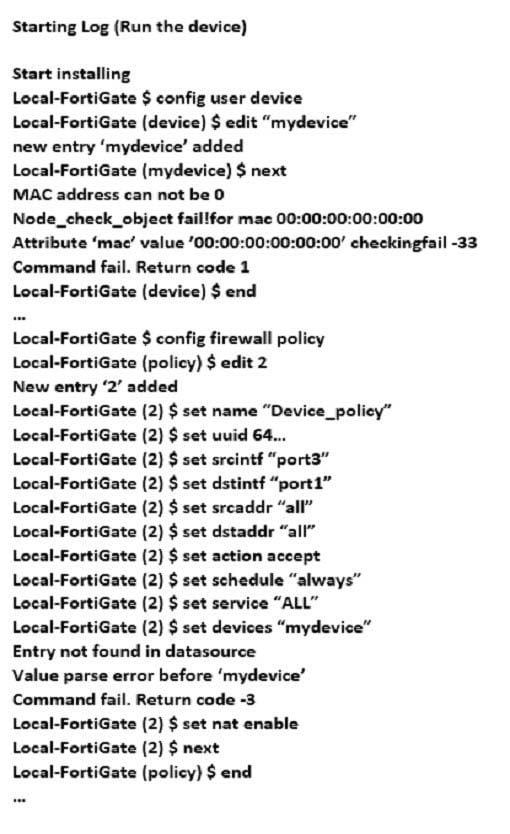NSE5_FMG-6.0 Online Practice Questions and Answers
Questions 4
View the following exhibit, which shows the Download Import Report:

Why it is failing to import firewall policy ID 2?
A. The address object used in policy ID 2 already exist in ADON database with any as interface association and conflicts with address object interface association locally on the FortiGate
B. Policy ID 2 is configured from interface any to port6 FortiManager rejects to import this policy because any interface does not exist on FortiManager
C. Policy ID 2 does not have ADOM Interface mapping configured on FortiManager
D. Policy ID 2 for this managed FortiGate already exists on FortiManager in policy package named Remote-FortiGate.
Questions 5
In addition to the default ADOMs, an administrator has created a new ADOM named Training for FortiGate devices. The administrator sent a device registration to FortiManager from a remote FortiGate. Which one of the following statements is true?
A. The FortiGate will be added automatically to the default ADOM named FortiGate.
B. The FortiGate will be automatically added to the Training ADOM.
C. By default, the unregistered FortiGate will appear in the root ADOM.
D. The FortiManager administrator must add the unregistered device manually to the unregistered device manually to the Training ADOM using the Add Device wizard
Questions 6
What configuration setting for FortiGate is part of a device-level database on FortiManager?
A. VIP and IP Pools
B. Firewall policies
C. Security profiles
D. Routing
Questions 7
Which of the following items does an FGFM keepalive message include? (Choose two.)
A. FortiGate uptime
B. FortiGate license information
C. FortiGate IPS version
D. FortiGate configuration checksum
Questions 8
An administrator would like to create an SD-WAN using central management. What steps does the administrator need to perform to create an SD-WAN using central management?
A. First create an SD-WAN firewall policy, add member interfaces to the SD-WAN template and create a static route
B. You must specify a gateway address when you create a default static route
C. Remove all the interface references such as routes or policies
D. Enable SD-WAN central management in the ADOM, add member interfaces, create a static route and SD-WAN firewall policies.
Questions 9
Which of the following statements are true regarding ADOM revisions? (Choose two.)
A. ADOM revisions can significantly increase the size of the configuration backups.
B. ADOM revisions can save the current size of the whole ADOM
C. ADOM revisions can create System Checkpoints for the FortiManager configuration
D. ADOM revisions can save the current state of all policy packages and objects for an ADOM
Questions 10
An administrator has added all the devices in a Security Fabric group to FortiManager. How does the administrator identify the root FortiGate?
A. By a dollar symbol ($) at the end of the device name
B. By an at symbol (@) at the end of the device name
C. By a question mark(?) at the end of the device name
D. By an Asterisk (*) at the end of the device name
Questions 11
View the following exhibit.

Which one of the following statements is true regarding installation targets in use Install On column?
A. The Install On column value represents successful installation on the managed devices
B. Policy seq#3 will be installed on all managed devices and VDOMs that are listed under Installation Targets
C. Policy seq#3 will be installed on the Trainer[NAT] VDOM only
D. Policy seq#3 will be not installed on any managed device
Questions 12
View the following exhibit.

Which statement is true regarding this failed installation log?
A. Policy ID 2 is installed without a source address
B. Policy ID 2 will not be installed
C. Policy ID 2 is installed in disabled state
D. Policy ID 2 is installed without a source device
Questions 13
View the following exhibit.

An administrator is importing a new device to FortiManager and has selected the shown options. What will happen if the administrator makes the changes and installs the modified policy package on this managed FortiGate?
A. The unused objects that are not tied to the firewall policies will be installed on FortiGate
B. The unused objects that are not tied to the firewall policies will remain as read-only locally on FortiGate
C. The unused objects that are not tied to the firewall policies locally on FortiGate will be deleted
D. The unused objects that are not tied to the firewall policies in policy package will be deleted from the FortiManager database
